Written by
Anthony Mollica Jr. posted on December 13, 2011 07:33
Editor’s note: Earlier this summer Anthony Mollica Jr. wrote about the Wela Ka Hao in his popular Thousand Island Sun column. Luckily for us, one of his readers wrote to TI Life asking how they could connect with Tony. A couple of emails later we began learning more about this beautiful craft – resulting in Tony’s writing this article for TI Life.
Some of the finest vintage boats built in the Thousand Islands originated in the small shop of Fitzgerald and Lee located on Sisson Street in Alexandria Bay. Owners Bernie Fitzgerald and Alfred Lee established their boat building firm in 1920. Their goal was to build thoughtfully designed, high quality boats for the discerning boaters of the Thousand Islands. During their twenty years of operation they achieved that goal with great success. Their boats were always designed with the special boating requirements of their individual clients as an important element.
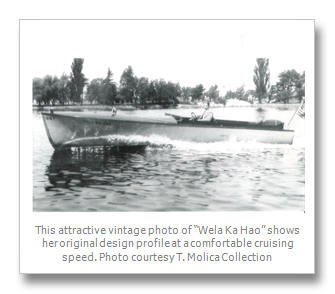
Gordon Kenyon, a recognized master craftsman in the north country, was always involved when a custom design project was undertaken by the firm. His woodworking skill was especially critical when the shop received requests to build boats designed by John L. Hacker. In the early 1930's Hacker began to embrace the art deco movement that became evident in a number of his most memorable boats. Often his creative designs employed complex curves that only a small number of builders possessed the skilled craftsmen to handle successfully and produce the required results.
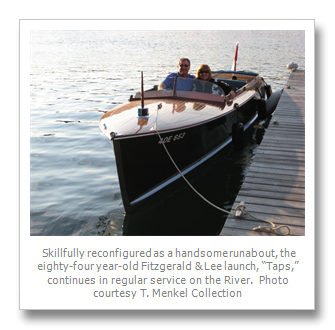
Fitzgerald and Lee's highly skilled craftsmen welcomed the challenge and took pride in their ability to successfully build mahogany hulls that displayed flowing curves that were often beyond the skill level of other shops. Among the best remembered Hacker-designed boats from the Fitzerald & Lee shop were: Frederick Bourne's runabout, “Messenger” (re-named, “Foot Loose, Fancy Free”), Charles Lyons' express cruisers, “Finesse” and “Vamoose”, Nils Johaneson's magnificent runabout “Skol” and Mary Hammond's slick runabout “Skid.” Each one a superb example of the art deco movement.
It was during the late summer of 1926 that Col. Harry Packer Wilbur of Reveille Island talked to Bernie Fitzgerald and discussed his ideas for a new boat. He was interested in a boat that would provide room enough to transport many of the necessities that island residents always require. From the mainland. The boat also needed to be comfortable for taking guests on scenic river tours as well as suitable for fishing trips with friends. Fitzgerald suggested that a launch of about 27 feet overall would likely meet the Colonel's needs. They discussed a number of the details that Col. Wilbur preferred and agreed upon a completion date so the boat would be ready to use during the 1927 summer season. Finally, Col. Wilbur requested that the name, Wela Ka Hao, be painted prominently on each side of the hull rather than on the traditional transom location due to the transom's original v-shaped design. According to the Wilbur family, the unusual name is a Hawaiian expression that means, “strike while the iron is hot” or “don't hesitate.” Colonel Wilbur's wife grew up in Hawaii where her family operated a large sugar plantation. The name was quite unusual and it wasn't long before the younger members of the family simply referred to the launch as, “Welly.”
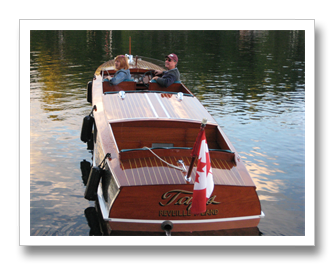
The magnificent launch was completed on schedule as promised. Wela Ka Hao met Col. Wilber's expectations so completely that it became his principle boat for the next twenty-five summer seasons. It provided excellent performance at every speed and had the room necessary for transporting island supplies. The boat's beautiful hull with its long, bright mahogany deck and gracefully curved stem made it one of the most distinctive launches on the River. She served the Colonel's boating needs superbly every summer. After his death in 1952, the boat was inherited by E. Packer Wilbur III. It was around this time that the boat received a major transformation. The new owner loved the hull and the way it performed at every speed. However, the launch style was considered old fashioned by 1950 boating standards. The owner wanted to upgrade “Welly's” appearance by installing a total new deck that would transform his launch into a stylish runabout with three-cockpits. This major transformation involved relocating the engine and the propeller shaft as well as moving the helm and steering system to a new forward location. The redesigned deck required a new seating arrangement and a modern windshield. The transformation was tastefully accomplished and achieved the refreshing new appearance that was anticipated.
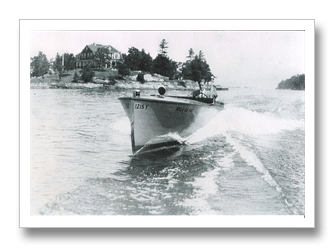
After nearly forty years in the Wilbur family, the boat was sold in 1990 to the owner of nearby Pine Island who continued to keep the boat in regular operation. After several seasons use, the boat was ready for needed restoration work. The Pine Island owner thought it might be a good time to offer the old boat to the current owner of Reveille Island, her original home port. They accepted the offer and decided to have Terry Senecal of Rockport, Ontario provide the boat with the work that was required.
Today the vintage launch continues to operate from her original home port on Reveille Island. She is a unique and attractive runabout that always challenges knowledgeable onlookers to contemplate its origins. Since the boat's appearance has been so dramatically transformed, her new owners decided that it was appropriate to rename the boat. Since their island is named, Reveille, they decided to rename the boat, “Taps.” She was built eighty-four years ago as a long deck launch named, “Wela Ka Hao” and now travels the River proudly as a handsome runabout named, “Taps,” and is recognized as a truly, wonderful Thousand Islands Classic.
By Anthony Mollica Jr.
|
Here is the letter sent to Tony Mollica. Hello Tony and thanks for the quick response – and thanks to Mike Franklin and Susan Smith at Thousand Islands Life for locating you for us!
With my sister Betsey Miner and brother Wells Wilbur, we are three of Colonel Harry Wilbur’s grandchildren and all of us spent many happy summers at Reveille Island from 1937 onward and know the Welly (what the family called our launch Wela Ka Hao) very well. All of us were together at the River last month, thanks to our cousins Dick and Mary Macsherry, and we each have a copy of your wonderful article about the Welly, now Taps.
According to our father, E. Packer Wilbur, III, she was built in Alexandria Bay in 1925 by Rolly Comstock and Roy Conklin with the original long bow and large aft cockpit. I think the reason that the name was painted on the side is that the original stern was a sort of a wide “V” in shape so there would have been no room for a name. Wela Ka Hao did come from Hawaii and we were told that it was an Hawaiian cheer and means “Strike while the iron is hot.” A quick Google search yields additional interesting information on the name. Mrs. Wilbur (Mary Cornwell Widdifield Wilbur our grandmother) grew up in Hawaii, in Honolulu and Maui, where the family was well known and owned a large sugar cane plantation.
Our grandfather acquired the boat in 1926 and we think that she was then known as “Lucky Strike” and had somehow suffered fire damage while under previous ownership. Somewhere between that time and the mid 1930’s Colonel Wilbur had Fitzgerald and Lee modify the boat to its present conformation but still with the “V” shaped stern. At that time the color was changed to black with a red bottom and a white waterline stripe.
During the 1950’s, I remember that the Welly often took on quite a bit of water overnight and had to be pumped in the morning with a small electric pump in the bow section of the bilge. At some point our dad had Eddie and Elmer Andress in Rockport re-plank and flatten the aft section of the bottom and widen the stern by about one foot, adding the present transom. This alteration did improve planing ability and reduced the lean caused by propeller torque. Probably made her faster too! She was originally powered by a converted Ford engine, then a Continental and, finally, a Chrysler Crown 150 HP engine. The large rudder behind the propeller and the propeller torque when in reverse made the Welly fun to maneuver and it required skill to slip her into a tight dock space at the Bay or in Rockport or Ivy Lea. We all learned to aquaplane and waterski in the Welly’s huge wake. The Welly delighted children by signaling her approach with a wonderful Model T ah-ooo-ga horn!
Our family loved the Welly and the lingering odor of fuel and varnish and the sounds she made as she moved with the current in her boathouse at Reveille.
Best and thanks for your interest and effort in writing about Wela Ka Ha”.
Packer Wilbur
|
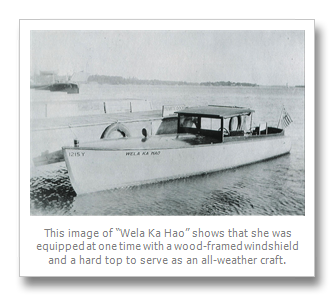
Anthony Mollica’s first wrote professionally in his teaching career in communications. Writing for pleasure evolved from his activities with the Antique and Classic Boat Society and the Antique Boat Museum as well as his life-long interest in the history of boat building in American. He has published articles in various marine periodicals including Classic Boating, ACBS Rudder, Gar Wood News, The Antique Boat Museum Gazette Annual, Motor Boating, Lakeland Boating and The Chris-Craft Brass Bell Quarterly. He is also the author of twelve published books, many of which are available in local book stores. In September 2010, TI Life reviewed Building Chris-Craft: Inside the Factories”. A book he wrote with Chris Smith, a member of the founding family. (See Anthony Mollica on our Publications page)